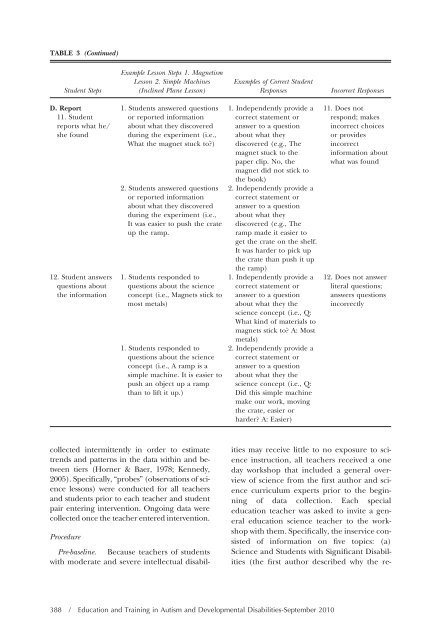Education and Training in Autism and Developmental Disabilities
Education and Training in Autism and Developmental Disabilities
Education and Training in Autism and Developmental Disabilities
Create successful ePaper yourself
Turn your PDF publications into a flip-book with our unique Google optimized e-Paper software.
TABLE 3 (Cont<strong>in</strong>ued)<br />
Student Steps<br />
D. Report<br />
11. Student<br />
reports what he/<br />
she found<br />
12. Student answers<br />
questions about<br />
the <strong>in</strong>formation<br />
Example Lesson Steps 1. Magnetism<br />
Lesson 2. Simple Mach<strong>in</strong>es<br />
(Incl<strong>in</strong>ed Plane Lesson)<br />
1. Students answered questions<br />
or reported <strong>in</strong>formation<br />
about what they discovered<br />
dur<strong>in</strong>g the experiment (i.e.,<br />
What the magnet stuck to?)<br />
2. Students answered questions<br />
or reported <strong>in</strong>formation<br />
about what they discovered<br />
dur<strong>in</strong>g the experiment (i.e.,<br />
It was easier to push the crate<br />
up the ramp.<br />
1. Students responded to<br />
questions about the science<br />
concept (i.e., Magnets stick to<br />
most metals)<br />
1. Students responded to<br />
questions about the science<br />
concept (i.e., A ramp is a<br />
simple mach<strong>in</strong>e. It is easier to<br />
push an object up a ramp<br />
than to lift it up.)<br />
collected <strong>in</strong>termittently <strong>in</strong> order to estimate<br />
trends <strong>and</strong> patterns <strong>in</strong> the data with<strong>in</strong> <strong>and</strong> between<br />
tiers (Horner & Baer, 1978; Kennedy,<br />
2005). Specifically, “probes” (observations of science<br />
lessons) were conducted for all teachers<br />
<strong>and</strong> students prior to each teacher <strong>and</strong> student<br />
pair enter<strong>in</strong>g <strong>in</strong>tervention. Ongo<strong>in</strong>g data were<br />
collected once the teacher entered <strong>in</strong>tervention.<br />
Procedure<br />
Pre-basel<strong>in</strong>e. Because teachers of students<br />
with moderate <strong>and</strong> severe <strong>in</strong>tellectual disabil-<br />
Examples of Correct Student<br />
Responses Incorrect Responses<br />
1. Independently provide a<br />
correct statement or<br />
answer to a question<br />
about what they<br />
discovered (e.g., The<br />
magnet stuck to the<br />
paper clip. No, the<br />
magnet did not stick to<br />
the book)<br />
2. Independently provide a<br />
correct statement or<br />
answer to a question<br />
about what they<br />
discovered (e.g., The<br />
ramp made it easier to<br />
get the crate on the shelf.<br />
It was harder to pick up<br />
the crate than push it up<br />
the ramp)<br />
1. Independently provide a<br />
correct statement or<br />
answer to a question<br />
about what they the<br />
science concept (i.e., Q:<br />
What k<strong>in</strong>d of materials to<br />
magnets stick to? A: Most<br />
metals)<br />
2. Independently provide a<br />
correct statement or<br />
answer to a question<br />
about what they the<br />
science concept (i.e., Q:<br />
Did this simple mach<strong>in</strong>e<br />
make our work, mov<strong>in</strong>g<br />
the crate, easier or<br />
harder? A: Easier)<br />
11. Does not<br />
respond; makes<br />
<strong>in</strong>correct choices<br />
or provides<br />
<strong>in</strong>correct<br />
<strong>in</strong>formation about<br />
what was found<br />
12. Does not answer<br />
literal questions;<br />
answers questions<br />
<strong>in</strong>correctly<br />
ities may receive little to no exposure to science<br />
<strong>in</strong>struction, all teachers received a one<br />
day workshop that <strong>in</strong>cluded a general overview<br />
of science from the first author <strong>and</strong> science<br />
curriculum experts prior to the beg<strong>in</strong>n<strong>in</strong>g<br />
of data collection. Each special<br />
education teacher was asked to <strong>in</strong>vite a general<br />
education science teacher to the workshop<br />
with them. Specifically, the <strong>in</strong>service consisted<br />
of <strong>in</strong>formation on five topics: (a)<br />
Science <strong>and</strong> Students with Significant <strong>Disabilities</strong><br />
(the first author described why the re-<br />
388 / <strong>Education</strong> <strong>and</strong> <strong>Tra<strong>in</strong><strong>in</strong>g</strong> <strong>in</strong> <strong>Autism</strong> <strong>and</strong> <strong>Developmental</strong> <strong>Disabilities</strong>-September 2010

















